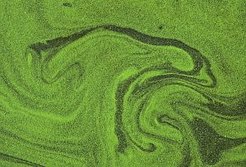Survival on Snowball Earth
Green algae form the foundation of the food pyramid on Earth and provide vital nutrients to myriad organisms. Scientists from the Max Planck Institute for Biogeochemistry in Jena and the University of Bremen have now discovered, together with colleagues from other countries, that the algae only gained this ecological relevance since the end of a global glaciation phase 635 million years ago. According to the researchers, novel fat molecules gave the green algae a survival edge. It allowed them to better resist the temperature fluctuations they were exposed to in their respective habitats.

But what was it that promoted the rise of the previously unimportant green algae? For Hallmann and his colleagues, the key to the answer possibly lies in what are known as the green algae's stigmasteroids. These fat molecules, related to cholesterol, are characteristic of green algae and can be found exclusively in rock samples younger than 635 million years. Stigmasteroids are steroids containing 29 carbon atoms – in comparison: well-known cholesterol has 27 carbon atoms.
The scientists analysed rock samples collected from around the globe, deposited before, during and after the great glaciation. The result: C-29 steroids are the most commonly represented in rock samples from the late ice age and the following ice-free age. In contrast, samples prior to this contain no stigmasteroids at all. “Regardless of whether at the tropics or the poles, in fresh water or ocean sediments – we simply cannot find them before this”, explains Yosuke Hoshino, the new study's main author.
Thus, there must be something about the longer fat molecules that allowed them to triumph in a relatively short time, and be utilized by cells around the globe since then. Earlier laboratory experiments by other scientists pointed Hallmann and his team in the right direction: if cells incorporate these long molecules in their cell membrane, they become more resistant to temperature fluctuations.
And these fluctuations even occurred during the millions of years of Earth's complete glaciation. According to a model study, ice-free areas exist on land even during such an extremely long glaciation Here, the rock weathers to dust, is carried away by the wind and collects again in different areas. In the sunshine, the dark rock dust warms faster than the bright ice and in some places small holes melted into the glacier. “Oases, where numerous organisms probably collected – and which were also exposed to large temperature fluctuations”, explains Hallmann.
The new results present a coherent image of an important period in the early stages of evolutionary development: initially, only a few green algae cells managed to produce new, longer steroids, thanks to random mutations. This allowed them to better resist the temperature fluctuations in the glacier pools and reproduce more frequently than their competing inhabitants. From this point on, they dominated the world's oceans for many millions of years.
